Overview
- Brief Narrative
- Ink drawing of the German defense counsel wearing headsets seated at their table created by 24 year-old Edward Vebell, illustrator and US soldier, from the press gallery during the first months of the 1945 Trial of German Major War Criminals before the International Military Tribunal in Nuremberg, Germany. Ed sat in the gallery for three days and used field glasses to capture the details of the defendant's faces. He had no water, so he had to use spit to create the halftones that add detail and nuance. Ed did 90% of his drawing in the courtroom, seeking to bring intimacy to the historical proceedings. The sketches were published in the US Army newspaper Stars and Stripes on December 9, 1945. The Waterman fountain pen he used for the drawings is record 2005.426.1. Ed was drafted into the US Army in 1942, and was the first staff illustrator for Stars and Stripes. His other assignments included combat zones in Italy and France. Soon after the defeat of Nazi Germany on May 7 in western Europe and May 9, 1945, in eastern Europe, the Allies: Great Britain, France, Soviet Union, and the United States convened an International Military Tribunal (IMT) at Nuremberg, Germany. Its purpose was to seek justice for crimes against humanity, evidenced by the Holocaust, perpetrated by Nazi Germany. In October 1945, the IMT formally indicted the Nuremberg defendants on four counts: crimes against peace, war crimes, crimes against humanity, and conspiracy to commit these crimes. The verdicts were delivered on October 1, 1946. Twelve defendants were sentenced to death; three to life imprisonment; four to prison terms ranging from 10-20 years; three were acquitted.
- Artwork Title
- German Defense Counsel, Nuremberg War Crimes Trials, 1945
- Date
-
creation:
after 1945 November 20-before 1945 December 09
publication/distribution: 1945 December 09
- Geography
-
creation:
courtroom, Trial of German Major War Criminals;
Nuremberg (Germany)
- Credit Line
- United States Holocaust Memorial Museum Collection, Gift of Sheila C. Johnson
- Contributor
-
Artist:
Edward Vebell
Subject: Edward Vebell
- Biography
-
Edward (Ed) Joseph Vebell was born on May 25, 1921, in Chicago, Illinois, to Joseph and Helen Rubeckas Vebell. His father was born in 1888 in Pasvitinys, Lithuania. His mother was born in 1897, also so Lithuania. He had two sisters. Edward’s talent for drawing was recognized at an early age and, as a teenager, he attended the Harrison Art School. By the age of eighteen, he was working as an illustrator. On graduating high school, he won scholarships to 3 art schools in Chicago, and he later studied in Paris, France. In December 1941, when the United States entered World War II, Edward was working as a commercial artist in Chicago, creating illustrations for the catalog companies Sears and Montgomery Ward.
Edward was drafted into the US Army on October 24, 1942. He was deployed to Casablanca in North Africa with the 904 Camouflage Engineers, where he painted desert camouflage on Army equipment. In February 1943, the Army newspaper Stars and Stripes opened an office in Algiers. Edward was transferred there as the first staff illustrator. A few months later, the paper added Stan Meltzoff and Bill Mauldin. Edward worked as a combat artist and correspondent and beginning in late 1943/1944, also did illustrations for Yank, a magazine published by and for enlisted men. Edward learned to capture the battles in ink and pencil on the job: “To be a good combat artist, you have to stand up and face in the enemy's direction. You can't do that for very long, or you'll be dead.” He was influenced by photography, but felt that drawing allowed him to impart a searching personal quality to the image. His assignments included frontline sketching in Italy for six months during the spring 1944 Monte Cassino campaign, with French troops in the Alps, and with French resistance fighters in the Pyrenees. He was sketching Russian forces a few days after the May 2, 1945, fall of Berlin. Germany surrendered on May 7. Edward then was based in Paris where he began doing freelance work for several French publications.
On December 17, 1942, the leaders of the United States, Great Britain, and the Soviet Union had issued a joint declaration resolving to prosecute those responsible for the mass murder of European Jewry. Six and a half months after the war ended, the Trial of German Major War Criminals before the International Military tribunal opened in Nuremberg on November 20, 1945. Edward was assigned by Stars and Stripes to create courtroom sketches at the trial. For three days, he sat in the press gallery and used binoculars to focus on the faces of the defendants, including Rudolf Hess and Hermann Goering. The field glasses reversed the images, which was an annoyance, but bearable for the detail they provided. Edward sketched directly in fountain pen, from right to left, using a moistened thumb to create tonal values. He did 90% of his drawing in the courtroom, seeking to bring intimacy to the historical proceedings. Ten drawing were published in the December 9, 1945, European issue of Stars and Stripes, his last assignment.
After his discharge from the military in late 1945, Edward established a commercial studio in Paris. He returned to the US in 1947 and continued his career as a commercial artist. His illustrations have appeared in books and periodicals, and clients have included Reader’s Digest, Life, Time, and Sports Illustrated. Edward also created murals for the National Park Service and sixteen stamps for the US Postal Service. He was especially sought after for his historical works, with their knowledgeable attention to detail and accuracy. Vebell also had an exceptional competitive fencing career. He was an international champion and member of the 1952 US Olympic team, and was named to the US Fencing Hall of Fame in 2014. He was married for nearly sixty years to Elsa Cerra (1926-2004), with whom he settled in Westport, Ct., and had three daughters.
Physical Details
- Language
- English
- Classification
-
Art
- Category
-
Drawings
- Object Type
-
Courtroom art (lcsh)
- Physical Description
- Black ink drawing on offwhite paper of 4 men in right profile, wearing black judicial robs and headsets, seated in curved back wooden chairs on one side of a panel table covered with papers. A briefcase sits on the floor, leaning against the table. The man in the front foreground look straight ahead, with his hands on his papers; the man to his left is looking down and writing; the next man sits at an angle and may be writing, and the fourth looks forward with his hand on his chin. Their heads are individualized, but not detailed. There is an inscription in black ink below the image; the artists's name and the year have been painted over with white ink. The drawings were published in a military newspaper and that may be why the information it is masked.
- Dimensions
- overall: Height: 15.250 inches (38.735 cm) | Width: 12.250 inches (31.115 cm)
pictorial area: Height: 8.375 inches (21.273 cm) | Width: 6.250 inches (15.875 cm) - Materials
- overall : wove paper, ink, tempera
- Inscription
- front, bottom, caption, cursive, black ink : the German / defense counsel - [Vebell 45 covered with white-out] / They were immediately in front of the / defendants _
Rights & Restrictions
- Conditions on Access
- No restrictions on access
- Conditions on Use
- No restrictions on use
Keywords & Subjects
- Topical Term
- Courtroom artists--Germany--Nuremberg--Biography. Nuremberg Trial of Major German War Criminals, Nuremberg, Germany, 1945-1946--Pictorial works. Nuremberg War Crime Trials, Nuremberg, Germany, 1946-1949--Pictorial works. Soldiers as artists--United States--Biography. War crime trials--Germany--Nuremberg--Pictorial works. World War, 1939-1945--Illustrators--Personal narratives, American. World War, 1939-1945--Journalism, Military--United States.
- Personal Name
- Vebell, Ed.
Administrative Notes
- Legal Status
- Permanent Collection
- Provenance
- The drawing was donated to the United States Holocaust Memorial Museum in 2003 by Sheila C. Johnson.
- Funding Note
- The cataloging of this artifact has been supported by a grant from the Conference on Jewish Material Claims Against Germany.
- Record last modified:
- 2022-09-09 11:27:46
- This page:
- https://collections.ushmm.org/search/catalog/irn521699
Download & Licensing
In-Person Research
- By Appointment
- Request 21 Days in Advance of Visit
- Plan a Research Visit
- Request to See This Object
Contact Us
Also in Edward Vebell collection
The collection consists of nine courtroom drawings created by Edward Vebell, US Army, during the Trial of German Major War Criminals before the International Military Tribunal in Nuremberg, Germany, which opened on November 20, 1945, following the end of World War II.
Date: 1945 October-1945 December

Portrait studies of defense lawyers created during the Trial of German Major War Criminals at Nuremberg
Object
Ink drawings of 5 defense lawyers in their judicial robes created by 24 year-old Edward Vebell, illustrator and US soldier, from the press gallery during the first months of the 1945 Trial of German Major War Criminals before the International Military Tribunal in Nuremberg, Germany. Ed sat in the gallery for three days and used field glasses to capture the details of the defendant's faces. He had no water, so he had to use spit to create the halftones that add detail and nuance. Ed did 90% of his drawing in the courtroom, seeking to bring intimacy to the historical proceedings. The sketches were published in the US Army newspaper Stars and Stripes on December 9, 1945. The Waterman fountain pen Edward used for the drawings is record 2005.426.1. Ed was drafted into the US Army in 1942, and was the first staff illustrator for Stars and Stripes. His other assignments included combat zones in Italy and France. Soon after the defeat of Nazi Germany on May 7 in western Europe and May 9, 1945, in eastern Europe, the Allies: Great Britain, France, Soviet Union, and the United States convened an International Military Tribunal (IMT) at Nuremberg, Germany. Its purpose was to seek justice for crimes against humanity, evidenced by the Holocaust, perpetrated by Nazi Germany. In October 1945, the IMT formally indicted the Nuremberg defendants on four counts: crimes against peace, war crimes, crimes against humanity, and conspiracy to commit these crimes. The verdicts were delivered on October 1, 1946. Twelve defendants were sentenced to death; three to life imprisonment; four to prison terms ranging from 10-20 years; three were acquitted.
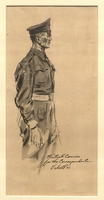
Portrait of a military courier created during the Trial of German Major War Criminals at Nuremberg
Object
Ink drawing of a British military courier created by 24 year-old Edward Vebell, illustrator and US soldier, from the press gallery during the first months of the 1945 Trial of German Major War Criminals before the International Military Tribunal in Nuremberg, Germany. Ed sat in the gallery for three days and used field glasses to capture the details of the defendant's faces. He had no water, so he had to use spit to create the halftones that add detail and nuance. Ed did 90% of his drawing in the courtroom, seeking to bring intimacy to the historical proceedings. The sketches were published in the US Army newspaper Stars and Stripes on December 9, 1945. The Waterman fountain pen he used for the drawings is record 2005.426.1. Ed was drafted into the US Army in 1942, and was the first staff illustrator for Stars and Stripes. His other assignments included combat zones in Italy and France. Soon after the defeat of Nazi Germany on May 7 in western Europe and May 9, 1945, in eastern Europe, the Allies: Great Britain, France, Soviet Union, and the United States convened an International Military Tribunal (IMT) at Nuremberg, Germany. Its purpose was to seek justice for crimes against humanity, evidenced by the Holocaust, perpetrated by Nazi Germany. In October 1945, the IMT formally indicted the Nuremberg defendants on four counts: crimes against peace, war crimes, crimes against humanity, and conspiracy to commit these crimes. The verdicts were delivered on October 1, 1946. Twelve defendants were sentenced to death; three to life imprisonment; four to prison terms ranging from 10-20 years; three were acquitted.
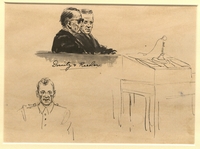
Courtroom sketch of 2 German Admirals created during the Trial of German Major War Criminals at Nuremberg
Object
Drawing of German Admirals Dönitz and Raeder conversing created by 24 year-old Edward Vebell, illustrator and US soldier, from the press gallery during the first months of the 1945 Trial of German Major War Criminals before the International Military Tribunal in Nuremberg, Germany. Ed sat in the gallery for three days and used field glasses to capture the details of the defendant's faces. He had no water, so he had to use spit to create the halftones that add detail and nuance. Ed did 90% of his drawing in the courtroom, seeking to bring intimacy to the historical proceedings. The sketches were published in the US Army newspaper Stars and Stripes on December 9, 1945. The Waterman fountain pen he used for the drawings is record 2005.426.1. Ed was drafted into the US Army in 1942, and was the first staff illustrator for Stars and Stripes. His other assignments included combat zones in Italy and France. Soon after the defeat of Nazi Germany on May 7 in western Europe and May 9, 1945, in eastern Europe, the Allies: Great Britain, France, Soviet Union, and the United States convened an International Military Tribunal (IMT) at Nuremberg, Germany. Its purpose was to seek justice for crimes against humanity, evidenced by the Holocaust, perpetrated by Nazi Germany. In October 1945, the IMT formally indicted the Nuremberg defendants on four counts: crimes against peace, war crimes, crimes against humanity, and conspiracy to commit these crimes. The verdicts were delivered on October 1, 1946. Twelve defendants were sentenced to death; three to life imprisonment; four to prison terms ranging from 10-20 years; three were acquitted.
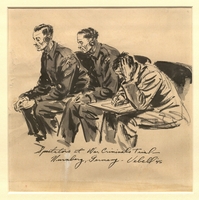
Drawing of courtroom observers created during the Trial of German Major War Criminals at Nuremberg
Object
Drawing of courtroom observers, two in military uniforms with CMP patches, created by 24 year-old Edward Vebell, illustrator and US soldier, from the press gallery during the first months of the 1945 Trial of German Major War Criminals before the International Military Tribunal in Nuremberg, Germany. Ed sat in the gallery for three days and used field glasses to capture the details of the defendant's faces. He had no water, so he had to use spit to create the halftones that add detail and nuance. Ed did 90% of his drawing in the courtroom, seeking to bring intimacy to the historical proceedings. The sketches were published in the US Army newspaper Stars and Stripes on December 9, 1945. The Waterman fountain pen he used for the drawings is record 2005.426.1. Ed was drafted into the US Army in 1942, and was the first staff illustrator for Stars and Stripes. His other assignments included combat zones in Italy and France. Soon after the defeat of Nazi Germany on May 7 in western Europe and May 9, 1945, in eastern Europe, the Allies: Great Britain, France, Soviet Union, and the United States convened an International Military Tribunal (IMT) at Nuremberg, Germany. Its purpose was to seek justice for crimes against humanity, evidenced by the Holocaust, perpetrated by Nazi Germany. In October 1945, the IMT formally indicted the Nuremberg defendants on four counts: crimes against peace, war crimes, crimes against humanity, and conspiracy to commit these crimes. The verdicts were delivered on October 1, 1946. Twelve defendants were sentenced to death; three to life imprisonment; four to prison terms ranging from 10-20 years; three were acquitted.
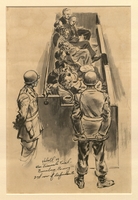
Drawing of a group of German defendants in their seats created during the Trial of German Major War Criminals at Nuremberg
Object
Ink drawing of the German defendants, including Goering, Hess, von Ribbentrop, and Keitel created by 24 year-old Edward Vebell, illustrator and US soldier, from the press gallery during the first months of the 1945 Trial of German Major War Criminals before the International Military Tribunal in Nuremberg, Germany. Ed sat in the gallery for three days and used field glasses to capture the details of the defendant's faces. He had no water, so he had to use spit to create the halftones that add detail and nuance. Ed did 90% of his drawing in the courtroom, seeking to bring intimacy to the historical proceedings. The sketches were published in the US Army newspaper Stars and Stripes on December 9, 1945. The Waterman fountain pen he used for the drawings is record 2005.426.1. Ed was drafted into the US Army in 1942, and was the first staff illustrator for Stars and Stripes. His other assignments included combat zones in Italy and France. Soon after the defeat of Nazi Germany on May 7 in western Europe and May 9, 1945, in eastern Europe, the Allies: Great Britain, France, Soviet Union, and the United States convened an International Military Tribunal (IMT) at Nuremberg, Germany. Its purpose was to seek justice for crimes against humanity, evidenced by the Holocaust, perpetrated by Nazi Germany. In October 1945, the IMT formally indicted the Nuremberg defendants on four counts: crimes against peace, war crimes, crimes against humanity, and conspiracy to commit these crimes. The verdicts were delivered on October 1, 1946. Twelve defendants were sentenced to death; three to life imprisonment; four to prison terms ranging from 10-20 years; three were acquitted.
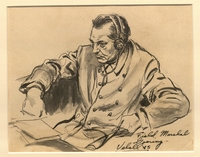
Courtroom portrait of Hermann Göring listening on headphones created during the Trial of German Major War Criminals at Nuremberg
Object
Portrait of Field Marshall Hermann Göring (Goering) created by 24 year-old Edward Vebell, illustrator and US soldier, from the press gallery during the first months of the 1945 Trial of German Major War Criminals before the International Military Tribunal in Nuremberg, Germany. Ed sat in the gallery for three days and used field glasses to capture the details of the defendant's faces. He had no water, so he had to use spit to create the halftones that add detail and nuance. Ed did 90% of his drawing in the courtroom, seeking to bring intimacy to the historical proceedings. The sketches were published in the US Army newspaper Stars and Stripes on December 9, 1945. The Waterman fountain pen he used for the drawings is record 2005.426.1. Ed was drafted into the US Army in 1942, and was the first staff illustrator for Stars and Stripes. His other assignments included combat zones in Italy and France. Soon after the defeat of Nazi Germany on May 7 in western Europe and May 9, 1945, in eastern Europe, the Allies: Great Britain, France, Soviet Union, and the United States convened an International Military Tribunal (IMT) at Nuremberg, Germany. Its purpose was to seek justice for crimes against humanity, evidenced by the Holocaust, perpetrated by Nazi Germany. In October 1945, the IMT formally indicted the Nuremberg defendants on four counts: crimes against peace, war crimes, crimes against humanity, and conspiracy to commit these crimes. The verdicts were delivered on October 1, 1946. Twelve defendants were sentenced to death; three to life imprisonment; four to prison terms ranging from 10-20 years; three were acquitted.
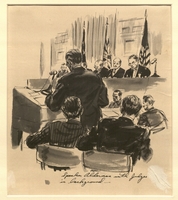
Courtroom portrait of Sidney Alderman, US prosecution team, created during the Trial of German Major War Criminals at Nuremberg
Object
Ink drawing of Sidney Alderman, US prosecutor, created by 24 year-old Edward Vebell, illustrator and US soldier, from the press gallery during the first months of the 1945 Trial of German Major War Criminals before the International Military Tribunal in Nuremberg, Germany. Ed sat in the gallery for three days and used field glasses to capture the details of the defendant's faces. He had no water, so he had to use spit to create the halftones that add detail and nuance. Ed did 90% of his drawing in the courtroom, seeking to bring intimacy to the historical proceedings. The sketches were published in the US Army newspaper Stars and Stripes on December 9, 1945. The Waterman fountain pen he used for the drawings is record 2005.426.1. Ed was drafted into the US Army in 1942, and was the first staff illustrator for Stars and Stripes. His other assignments included combat zones in Italy and France. Soon after the defeat of Nazi Germany on May 7 in western Europe and May 9, 1945, in eastern Europe, the Allies: Great Britain, France, Soviet Union, and the United States convened an International Military Tribunal (IMT) at Nuremberg, Germany. Its purpose was to seek justice for crimes against humanity, evidenced by the Holocaust, perpetrated by Nazi Germany. In October 1945, the IMT formally indicted the Nuremberg defendants on four counts: crimes against peace, war crimes, crimes against humanity, and conspiracy to commit these crimes. The verdicts were delivered on October 1, 1946. Twelve defendants were sentenced to death; three to life imprisonment; four to prison terms ranging from 10-20 years; three were acquitted.
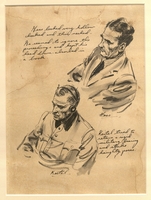
Courtroom portraits of Rudolph Hess and Wilhelm Keitel created during the Trial of German Major War Criminals at Nuremberg
Object
Portrait studies of Rudolph Hess and Wilhelm Keitel, German defendants, created by 24 year-old Edward Vebell, illustrator and US soldier, from the press gallery during the first months of the 1945 Trial of German Major War Criminals before the International Military Tribunal in Nuremberg, Germany. Ed sat in the gallery for three days and used field glasses to capture the details of the defendant's faces. He had no water, so he had to use spit to create the halftones that add detail and nuance. Ed did 90% of his drawing in the courtroom, seeking to bring intimacy to the historical proceedings. The sketches were published in the US Army newspaper Stars and Stripes on December 9, 1945. The Waterman fountain pen he used for the drawings is record 2005.426.1.Ed was drafted into the US Army in 1942, and was the first staff illustrator for Stars and Stripes. His other assignments included combat zones in Italy and France. Soon after the defeat of Nazi Germany on May 7 in western Europe and May 9, 1945, in eastern Europe, the Allies: Great Britain, France, Soviet Union, and the United States convened an International Military Tribunal (IMT) at Nuremberg, Germany. Its purpose was to seek justice for crimes against humanity, evidenced by the Holocaust, perpetrated by Nazi Germany. In October 1945, the IMT formally indicted the Nuremberg defendants on four counts: crimes against peace, war crimes, crimes against humanity, and conspiracy to commit these crimes. The verdicts were delivered on October 1, 1946. Twelve defendants were sentenced to death; three to life imprisonment; four to prison terms ranging from 10-20 years; three were acquitted.



